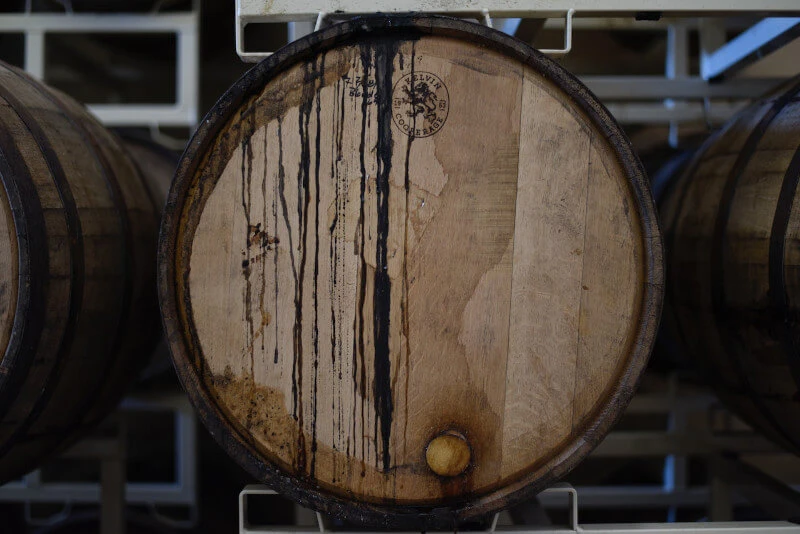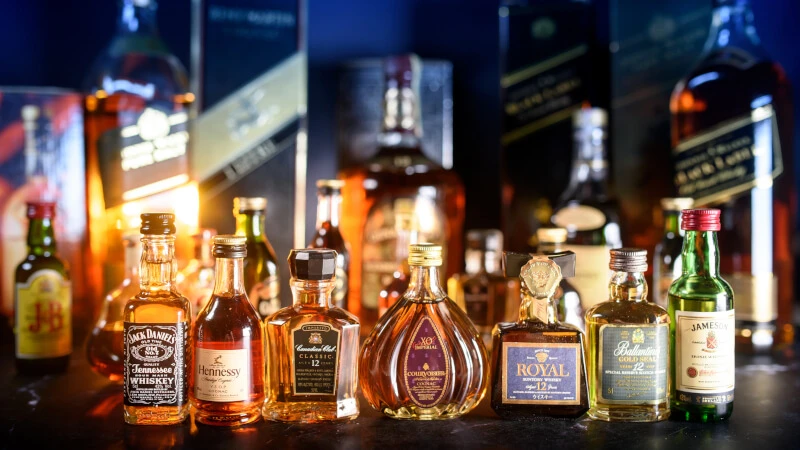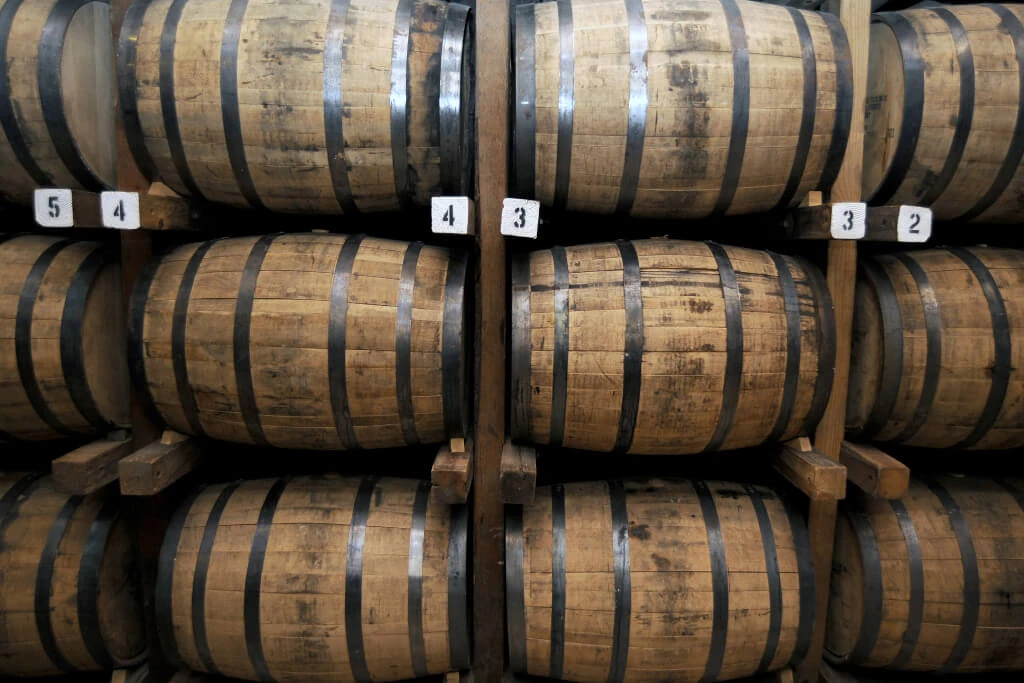Do you ever sit back and wonder how many bottles you could get out of a single barrel of Scotch whiskey? Only individuals who have experience with distillation would know this, although most people assume it goes without saying.
How many whiskey bottles does a barrel hold? On average, a barrel of whiskey can hold about 53 gallons. The standard bottle capacity is 750 ml. This means that there are roughly 267 12 bottles of whiskey in a barrel. However, it’s not quite that straightforward of an answer.
The number of bottles that can be produced from a given barrel varies greatly because of the wide variety of barrels (or casks) available. In addition, the Angel’s Share and the method of bottling all play a role in reducing the potential yield of a single barrel.
How Many Whiskey Bottles Fit in a Barrel?
You’ll need to know how to measure volumes and do some simple calculations. You don’t need to be a genius to remember a few easy conversions. Many people use either gallons or liters when talking about the number of bottles that are in a barrel of whiskey. This is then converted to ounces, liters, milliliters, or centiliters for use in filling bottles. Here’s how to do the conversion:
- One US, Canadian, or European gallon is equal to 128 fluid ounces (3.78 liters)
However, these standards vary depending on your location. Indicators used in the US vary from those used in Europe or even Canada. Bottles in the United States often contain one or two liters of liquid, although in Europe one or two centiliters is more usual. Canada, on the other hand, frequently uses fluid ounces.
A 1.75-liter bottle, known as a “handle” in the United States, is equivalent to a 60 or 60-pounder in Canada. Approximately 60 fluid ounces. However, a standard 750mL or 75cL bottle will be used for all calculations. Both of these amounts are equivalent to a third of a liter.
Cask Varieties

It stands to reason that the kind of cask used to mature and/or finish a barrel of whiskey will have a direct impact on the yield. Casks are often made out of oak. The most common sizes are either a hogshead or an American standard barrel.
While some casks are used to age whiskey, others are reserved for the finishing process. These containers range from quarters to barriques to butts to Madeira drums to puncheons to port pipes. Some more exist, but the most common ones are described below, along with their bottle capacity and size.
A Quarter Cask
The smallest casks used for whiskey aging and finishing are quarter casks. The premise behind their use by coopers is that it speeds up the aging process. The whiskey will age and mature more quickly because of the increased contact with wood:
- One-quarter cask can provide up to 66 75cL bottles, as it contains roughly 11 to 13 gallons (45 to 50 liters).
Standard American Barrel
Most people mean the American conventional barrel when they say “barrel.” These barrels are the standard for aging Bourbon. After being used to age Bourbon, they are sent to Scotland to be repurposed for Scotch whiskey. This is because Bourbon contributes sweet notes of vanilla and caramel. There are approximately 190 to 200 liters (50 to 53 gallons) of whiskey in a normal American oak barrel. This means that between 253 to 266 75-milliliter bottles of whiskey can be made from a single ordinary barrel.
Pigshead Barrels
When reusing Bourbon barrels, coopers typically use extra staves to create larger casks known as hogsheads. The origin of the name “hogshead” for a barrel or cask is unclear. On the other hand, it could be a Norse or Germanic name for an ancient unit of measurement. About 225–250 liters (60–66 US gallons) of whiskey can be stored here. 333 bottles of 75 cL capacity can be filled from a single hogshead.
Barrique Barrels
Barrique barrels are another form of repurposed cask commonly used to age or finish whiskey. These are used in the production of wine and are typically made of French oak. The enormous diameter of these cylinders exceeds their length due to a central bulge. These can carry approximately 250-300 liters (roughly 66-80 gallons). This equates to a donation of between 333 and 400 75-cL bottles.
Puncheon Barrels
Puncheon casks are typically used for the first aging of sherry and rum. They are then sent to Scotch whiskey distilleries, where they add a unique flavor to the final whiskey. A puncheon is also the name of a unit of measurement in traditional English usage. These can store anywhere from 450 to 500 milliliters or 118 to 132 gallons. This is roughly equivalent to 600–667 750-milliliter bottles.
The Butt Cask
The butt cask is a classic measurement system that evolved from the hogshead cask. One butt cask was equivalent to two hogsheads in this way. These are the standard casks for making sherry nowadays. These can store between 475 and 500 liters (128 and 132 gallons) of Scotch whiskey. About 633–667 standard-sized wine bottles can be produced from one batch of these.
Port Wine Barrels
The port pipe cask is a huge type of barrel that is often produced in Europe. whiskey is typically finished in these instead of aged.
A typical port pipe barrel can store between 550 and 650 liters of whiskey or 145 to 171 gallons. That’s the equivalent of 733-866 75-cL bottles of whiskey that can be made from a single port pipe cask.
Drum of Madeira
The Madeira drum is the most prestigious cask since it is the largest and is constructed from the thickest staves of European oak. Scotch whiskey is aged in these barrels, which may store anywhere from 600 to 650 liters, or around 800 to 866 75 cL bottles.
How Many Whiskey Bottles Can Fit Into a Barrel and Why

The number of bottles that can be filled from a single barrel of whiskey depends on a wide variety of parameters. Age and volume can be affected by both the Angel’s Share and the act of bottling.
An Angel’s Share
While whiskey is aging, some of it will naturally evaporate. The amount of whiskey in the barrel decreases by around 2% per year due to this process. The porous barrel allows some of the spirit to evaporate, resulting in the “Angel’s Share.” According to the myth, this is where a soul ascends to the afterlife. This slight reduction in barrel capacity is beneficial, as it aids in filtering out some of the less desirable characteristics that develop during aging. The Angel’s Share affects both the ages of the barrels and the environment in which the age of casks.
Due to the “Angel’s Share,” a barrel of whiskey yields between 150 and 200 750-ml bottles instead of the standard 100. Based on the information provided above, it is safe to assume that fewer bottles of whiskey fit within a barrel of whiskey.
Alcohol Percentages
To offset this loss, some distillers dilute their casks while they age. Distilled alcohol can only legally contain 40% alcohol by volume. However, with time, even this is lost when the barrel dries up.
Therefore, certain barrels will age for as little as two or three years and as long as seventy-five or eighty. Including Angel’s Share, the loss throughout the minimum maturity period is roughly 4-6%. However, for more protracted aging processes, this number might approach 160%. To gauge how many bottles may be extracted from a barrel of whiskey, it will be necessary to add water to the mixture over time.
Methods of Bottling
When the time for aging is up, the product is filtered and put into bottles. Both of these processes can help reduce the amount of liquid left in the barrel. The possible values are 1% and 5%. The exposure of the whiskey to oxygen during filtration and consequent pouring into bottles is to blame. In addition, broken bottles or spilled whiskey are both possible outcomes. Naturally, this reduces yield even further.
All of These Factors Together Diminish the Yield of a Single Batch of Whiskey
Since most whiskey is aged in American standard barrels, you may roughly estimate that you will obtain 253 to 266 bottles of 75cL or 750mL size. However, this may vary depending on the manufacturer and whether or not they employ a finishing procedure in a different barrel, such as a Madeira drum.
Add in the costs of Angel’s Share, filtering, and bottling, and you’re looking at a loss of around 10%. Again, though, this will be contingent on how long the barrel is aged. The answer to the question “How Many Bottles are in a Barrel of whiskey?” is thus significantly more involved than initially anticipated, given the need to account for all these variables.
Danielle’s Unique Bio:
Meet Danielle, a whiskey whisperer and a wordsmith whose tales of the golden elixir have graced the pages of Black Serpent, Bottle Storage, and Cipro.

